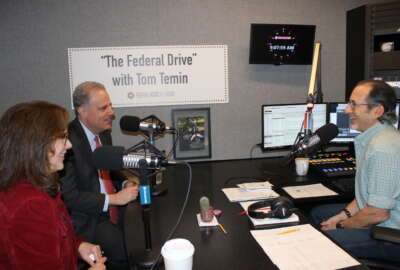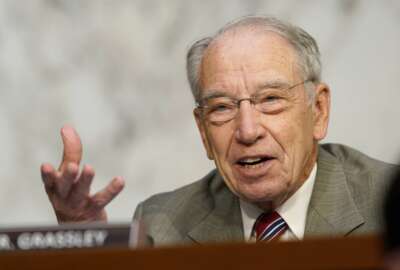Hubbard Radio Washington DC, LLC. All rights reserved. This website is not intended for users located within the European Economic Area.
On Air: Federal News Network
Trending:
New metrics to help agencies determine value of social media
GSA led a 12-member interagency working group to create a set of measures specifically aimed at defining the usefulness of social media for agencies. The agency...
wfedstaff | April 17, 2015 4:43 pm
Many agencies have jumped into the social media pool of Facebook, Twitter, Foursquare and many others without fully understanding why they’re doing it.
The General Services Administration is trying to help answer the question of whether agencies receive value from using social media.
GSA led a 12-member interagency working group, including NASA and the departments of Defense and State, to create a set of metrics specifically aimed at defining the value of social media for federal agencies.
Justin Herman, the lead for social media in GSA’s Center for Excellence in Digital Government, said Tuesday the way private sector companies measure the impact of social media doesn’t work for federal agencies. 
The metrics are broken down into 10 areas across seven categories:
- Breadth – Subcategories include community size and community growth
- Depth – Subcategories include conversions and viewing
- Direct engagement – Subcategories include engagement volume and engagement responsiveness.
- Loyalty – Subcategories include return community
- Customer experience – Subcategories include sentiment, indicators and survey feedback.
- Campaigns – No subcategories
- Strategic outcomes – No subcategories
“This is not set in stone because it can’t be,” Herman said. “We recognize the fact in order to have credible social media performance metrics, it’s going to change once a week, once a month. It has to be a living, breathing document. That’s why we released it and asked the public to help keep it updated.”
In addition to the metrics, GSA released an API (application programming interface) that lets users create tools to bring together government social media feeds in one place. GSA created a social media registry and now citizens can customize the feeds they receive.
Herman said they could focus on specific key words, topical areas or agencies and receive all the social media feeds on those subjects.
“We have the social media registry. It’s up there, it’s live. It has over 2,000 accounts in it and we still are adding more. It’s an open source tool, by the way,” he said. “While we have just federal agencies in it, this is something that can spread to state and local governments too. It’s the API we want people to use. That’s the data stream that you can customize and use to link together new tools and create new tools.”
Hackathon to create tools
Herman said GSA wants small businesses, entrepreneurs and other innovators to use the API to create apps or tools for people to take advantage of the government data.
In fact, Wednesday during Social Media week, GSA is holding a hackathon to spur the development of tools using the API.
“It’s of a lot of people’s opinion, APIs should be attached to all of these sites because this is stuff the public already owns,” Herman said. “APIs are a great way to open up and unlock that data so they can provide those services, so they can fully use it because if not, as we know, sometimes technology can raise barriers and make things more difficult, especially if you have to hunt things down. What APIs will do is jell everything together so you can go to one point of entry but then access everything you want, and have full keys to the kingdom.”
Both of these efforts are part of the White House’s Digital Government Strategy, released in May 2012. The Office of Management and Budget soon will release a new “governmentwide open data, content and Web API policy and identify standards and best practices for improved interoperability.”
Under the strategy, the social media metrics were due by August 2012, and the Web API policy was due in November.
Agencies slowly are realizing the platform isn’t as important as the data. A report by the Partnership for Public Service and Booz Allen Hamilton in January highlighted successful social media use cases and nearly all of them were focused on the data more than how the public consumed the information.
Finding meaningful metrics
Herman said APIs and social media metrics will improve the management of data.
“We show how to, in Google Analytics, to do conversations, place a value on it and benchmark customer response times,” he said. “We wanted to find and go through all the freely available tools that are open and accessible to any program manager in government, like Twitter’s own analytic system or Facebook Insights and stitch together and cherry pick what are those metrics that help tell the story. That’s part of what the recommendations do is, you take these simple numbers and it shows you how to match it with strategic goals. That’s how we approached it. We wanted it to be free, easily measurable, easy to analyze to set that new baseline for where agencies are, who might just be reporting their number of followers at their metrics currently.”
Nearly every agency is struggling with how make social media meaningful and measure the impact it has on helping the agency meets its mission. The National Institutes of Health released a request for quote Feb. 11 asking a small business to develop two sets of metrics for the National Library of Medicine to measure its social media impact.
Bids are due Feb. 26 and should address both consumer usage and health professional and biomedical usage of NLM data through social media outlets.
The National Archives and Records Administration is focusing on user adoption and participation.
NARA is using crowdsourcing to address several mission areas, including tagging of photos and transcribing documents.
Crowdsourcing at NARA
Pamela Wright, NARA’s chief innovation officer, said a lot of the agency’s forays into social media are on a small scale, and if there is success they expand it.
For example, she said, NARA set up a pilot using Drupal to see if volunteers would transcribe handwritten documents. NARA started off with 1,000 pages, and within two weeks, it was done.
Wright said that success is leading to a greater effort to have people help with transcribing thousands of pages of documents.
“What I think we will see this year in 2013 is an intersection of social, data and mobile,” said Sheila Campbell, GSA’s director of the Center for Excellence in Digital Government. “Agencies aren’t using social media just for the sake of using social media. So many of us are at organizations where we hear ‘Hey, I need a Facebook page, or we need to set up a YouTube account.’ But some agencies have gone way beyond the very initial phases of developing a social media presence, and they are flipping the equation and saying ‘What are the problems we are trying to solve and how do we use these technologies to drive results?'”
RELATED STORIES:
OMB unveils ambitious digital mobile strategy
White House to mandate machine readable, open data
New era of social media pushes agencies toward data away from platforms
Copyright © 2024 Federal News Network. All rights reserved. This website is not intended for users located within the European Economic Area.
Jason Miller
Jason Miller is executive editor of Federal News Network and directs news coverage on the people, policy and programs of the federal government.
Follow @jmillerWFED





